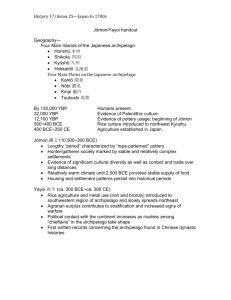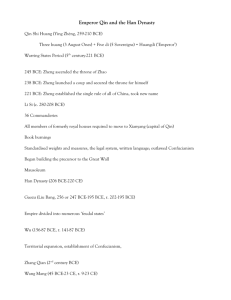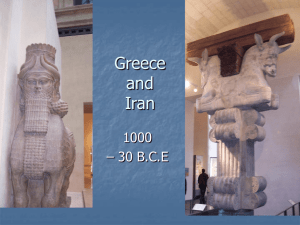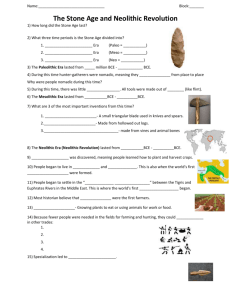page184_sidebar_2
advertisement
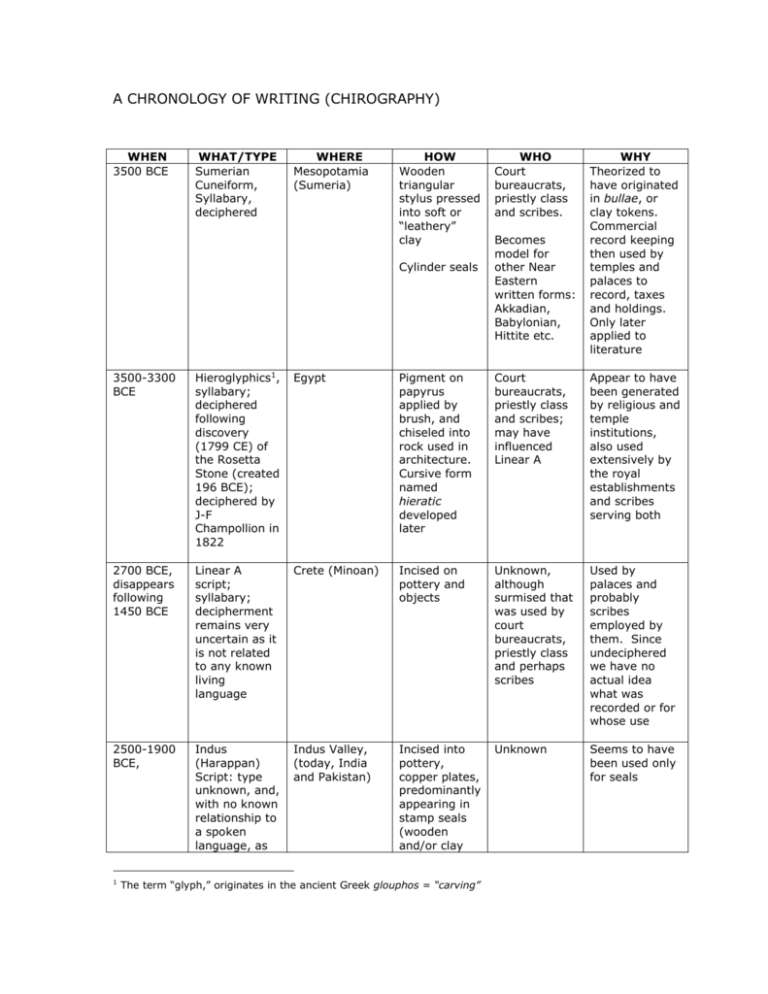
A CHRONOLOGY OF WRITING (CHIROGRAPHY) WHEN 3500 BCE WHAT/TYPE Sumerian Cuneiform, Syllabary, deciphered WHERE Mesopotamia (Sumeria) HOW Wooden triangular stylus pressed into soft or “leathery” clay Cylinder seals WHO Court bureaucrats, priestly class and scribes. Becomes model for other Near Eastern written forms: Akkadian, Babylonian, Hittite etc. WHY Theorized to have originated in bullae, or clay tokens. Commercial record keeping then used by temples and palaces to record, taxes and holdings. Only later applied to literature 3500-3300 BCE Hieroglyphics1, syllabary; deciphered following discovery (1799 CE) of the Rosetta Stone (created 196 BCE); deciphered by J-F Champollion in 1822 Egypt Pigment on papyrus applied by brush, and chiseled into rock used in architecture. Cursive form named hieratic developed later Court bureaucrats, priestly class and scribes; may have influenced Linear A Appear to have been generated by religious and temple institutions, also used extensively by the royal establishments and scribes serving both 2700 BCE, disappears following 1450 BCE Linear A script; syllabary; decipherment remains very uncertain as it is not related to any known living language Crete (Minoan) Incised on pottery and objects Unknown, although surmised that was used by court bureaucrats, priestly class and perhaps scribes Used by palaces and probably scribes employed by them. Since undeciphered we have no actual idea what was recorded or for whose use 2500-1900 BCE, Indus (Harappan) Script: type unknown, and, with no known relationship to a spoken language, as Indus Valley, (today, India and Pakistan) Incised into pottery, copper plates, predominantly appearing in stamp seals (wooden and/or clay Unknown Seems to have been used only for seals 1 The term “glyph,” originates in the ancient Greek glouphos = “carving” yet undeciphered. Some scholars even reject it as a form of writing. templates?) c. 1850 BCE Deriving from Proto-Sinaitic, the Semitic scripts; Phoenician and Aramaic abjads2. The Levant, ultimately develops in Phoenicia (modern Lebanon), Syria and Palestine/Israel, later providing basis of Arabic script. Ancient Greeks will adapt these symbols into the first alphabet Incised or carved onto objects and pottery, as well as used in graffiti Being easier to learn than hieratic or cuneiform was probably used by a larger portion of population. Earliest forms found in graffiti incised by itinerant workmen travelling between their homes in the Levant and Egypt where work was to be found Administrative and religious uses. Phoenician inscribed into objects to dedicate them to owners or gods. Since Phoenicians were the main traders in the Mediterranean, their inscriptions can be though of as originating commercial branding c. 17661122 BCE; although there are indications the script may go back as far as 8000 BP. Legendary origins suggest they characters were invented by Cangjie, a government official, c. 2650 BCE Sinography, Chinese characters Shang Dynasty China, Appearing first on oracle bones3, then cast in bronze on votive and ritual objects. Written by brush into strip of bamboo tied to scrolls, and then later onto paper Scribes and scholars, teachers, court officials and bureaucrats Religious and palace administrational uses. Dedication of votive and ritual objects. Engraved in stellae. 1200 – 900 BCE; disappears Linear B, “Mycenaean” script, Crete and on Greek mainland after fall of Incised onto clay tablets Used predominantly by palace Administration and recordkeeping, also An abjad is any writing system wherein consonants are written although no symbols are available for vowels, the latter being represented by diacritical markings above consonants. Hebrew and Arabic are abjads. 2 3 Used to record divinations conducted for the Shang royal household. completely during the Greek Dark age deciphered by Michael Ventris 19511953. Minoan power post 1450 BCE. While closely related to Linear A, it was used to encode an early form of Greek spoken by the Mycenaean civilization c. 700 BCE Greek alphabet: composed of symbols representing sounds, “vocalic” writing providing symbols for consonants and vowels; adapted by Greeks from Phoenician abjad Taught in schools to boys of upper classes, and relatively widespread in urban populations. Hesiod (c. 750650 BCE), a farmer, wrote suggesting that the spread of literacy was not limited to urban contexts. Incised and carved into objects and on pottery, written with a reed pan on papyrus imported from Egypt as well as on wax tablets with a stylus. Carved onto stone stellae. scribes in administrative applications and contexts some use in correspondence and early chronological accounts Scribes as well as lay populations, upper classes predominantly Used for dedications, poetry, and within 350 years, during the “Golden Age” years for prose, historian Herodotus (484-425 BCE) and polymaths Plato (428-348 BCE) and Aristotle (384322 BCE), being among early practitioners of prose form.





